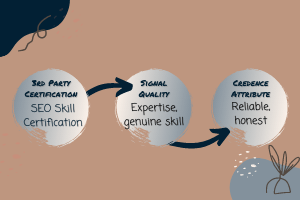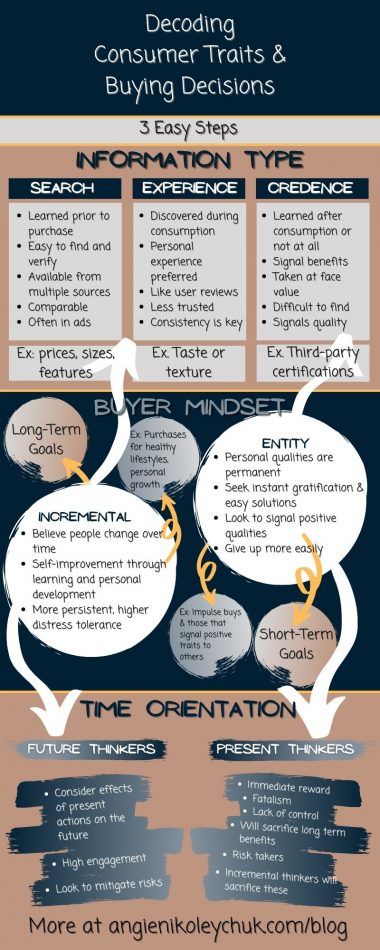You’ve gathered demographic information for your target market. You set everything up and waited for the sales to roll in, but they never came. Why? The answer could be in some of the basics of consumer psychology and your target market’s unique buying decision process.
Here’s the quick version:
- Understand how consumers use types of product information
- Identify the mindset of your target market
- Know your audience’s time bias or preferred orientation
Step 1 – Product Information Types Sought By Consumers
To understand what information works best for your target market, you must know when customers use each information type and why. To do that, we can use a system called SEC framework (Search, Experience, Credence):
- Search: This attribute includes details learned before the purchase, such as price, size, or features. They come from a multitude of sources, including ads and product descriptions.
- Experience: Customers learn experience attributes like taste, quality, or comfort while consuming a product or service. User reviews can turn experiential features into search information. However, consumers see these as less trustworthy than a first-hand experience, so you’ll need to take extra steps to counter this side effect.
- Credence: Information in the credence category signals benefits, which consumers discover after using a product or service. Of course, you can suggest benefits, but these are subjective and not as trustworthy. One way around this is through third-party certification. Examples here include environmentally or socially responsible, reliability, and quality results.

Step 2 – Identify Your Target Market’s Mindset
Consumer psychology tells us information types can motivate one person while discouraging another. One determining factor? The consumer’s mindset.
Incremental Thinkers: Individuals with this mindset believe their personalities and characteristics are malleable. In other words, they think they can change aspects of themselves through personal growth and development. As a result, they’ll have:
- Higher distress tolerance
- Better coping mechanisms
- Higher risk tolerance
- Seek products and services that help achieve goals
- Prioritize experiential attributes and information during buying decisions. (The “E” in the SEC framework.)
- Ex: Exercise, education, or healthy lifestyle products.
Entity Thinkers: This group believes their personalities and qualities are permanent; nothing they do will improve their flaws. Their goal? Instant satisfaction or benefits. Entity thinkers have:
- Less effective coping strategies
- Lower tolerance for frustration
- A preference for easy solutions
- Seek quick returns
- Prioritize credence and search attributes (S and C in the SEC framework)
- Ex: Entertainment, short classes as opposed to degrees, luxury items.
There are two essential details to note about entity thinkers, however:
1 – While they aren’t interested in more long-term benefits and growth, they will be motivated by the same things as incremental thinkers if they signal a positive trait to others.
2 – Encouraging incremental thinkers can turn them into entity thinkers. They may lower their expectations of themselves and be discouraged from longer-term goals.
How do you know when you’re dealing with one of these situations? It depends on the individual’s time bias.
Step 3 – Determine Your Target Audience’s Time Orientation
We usually organize experiences and information through a temporal framework. We’re biased toward past, present, or future-oriented information, and this bias changes depending on the context and situation. A past temporal bias is a vast subject with various causes and is highly specific to each incident. Present and future biases, however, are a bit more consistent and predictable:
- Present-Time Bias: When using this bias, people look for immediate cues and rewards. They’re less risk-averse, exercise less control, and may even have higher levels of fatalism (entity mindset). Be aware, however: This bias leans more toward spontaneity than long-term commitment.
- Future-Oriented Bias: With this bias, people weigh present actions against future outcomes. They will be more engaged with a task and try to avoid or eliminate risk. It’s ideal for incremental figures because it aligns with their personal development goals.
These three consumer psychology steps will help you understand your target market, but they aren’t completely static. You’ll find variations within target audiences often because of the context or channel. If you miss them, these can be a massive problem, but identifying them early can turn into big conversion wins.

References:
Roy, Rajat, and Vik Naidoo. “The Role of Implicit Lay Belief, SEC Attributes and Temporal Orientation in Consumer Decision Making.” Journal of Business Research, vol. 122, 2021, pp. 411–22. Crossref, doi:10.1016/j.jbusres.2020.09.024.
Korgaonkar, Pradeep, et al. “Product Classifications, Consumer Characteristics, and Patronage Preference for Online Auction.” Journal of Retailing and Consumer Services, vol. 17, no. 4, 2010, pp. 270–77. Crossref, doi:10.1016/j.jretconser.2010.02.004.
Nelson, Phillip. “Information and Consumer Behavior.” Journal of Political Economy, vol. 78, no. 2, 1970, pp. 311–29. Crossref, doi:10.1086/259630.
Nelson, Phillip. “Advertising as Information.” Journal of Political Economy, vol. 82, no. 4, 1974, pp. 729–54. Crossref, doi:10.1086/260231.
